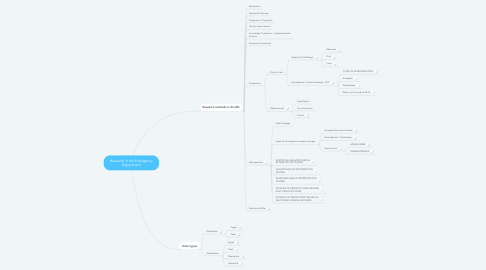
1. Data Types
1.1. Qualitative
1.1.1. Types
1.1.2. Tests
1.2. Quantitative
1.2.1. Types
1.2.2. Tests
1.2.3. Descriptive
1.2.4. Inferential
2. Research methods in the ED
2.1. Qualitative
2.2. Systematic Reviews
2.3. Diagnostic / Prognostic
2.4. Quality Improvement
2.5. Knowledge Translation / Implementation Science
2.6. Economic Evaluations
2.7. Prospective
2.7.1. Clinical trials
2.7.1.1. Adaptive Trial Design
2.7.1.1.1. Rationale
2.7.1.1.2. Pros
2.7.1.1.3. Cons
2.7.1.2. Nonadaptive / fixed trial design - RCT
2.7.1.2.1. TYPES OF RANDOMISATION
2.7.1.2.2. Strengths
2.7.1.2.3. Weaknesses
2.7.1.2.4. When not to conduct RCTs
2.7.2. Observational
2.7.2.1. Case Report
2.7.2.2. Cross Sectional
2.7.2.3. Cohort
2.8. Retrospective
2.8.1. Data Linkages
2.8.2. types of retrospective research designs
2.8.2.1. retrospective cohort studies
2.8.2.2. Case Reports / Case Series
2.8.2.3. Case-control
2.8.2.3.1. ADVANTAGES
2.8.2.3.2. DISADVANTAGES
2.8.3. STATISTICAL ANALYSIS USED IN RETROSPECTIVE STUDIES
2.8.4. ADVANTAGES OF RETROSPECTIVE STUDIES
2.8.5. DISADVANTAGES OF RETROSPECTIVE STUDIES
2.8.6. SOURCES OF ERROR IN CHART REVIEWS AND THEIR SOLUTIONS
2.8.7. SOURCES OF ERROR FROM THE USE OF ELECTRONIC MEDICAL RECORDS
